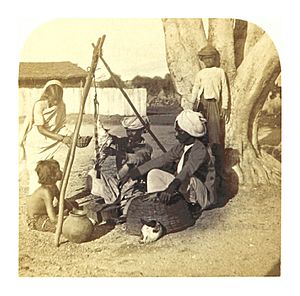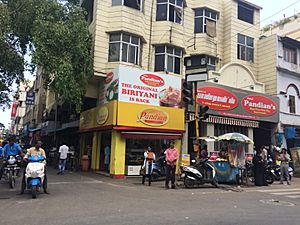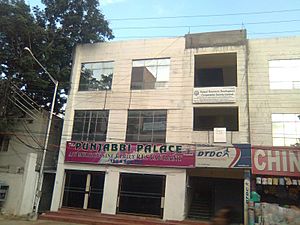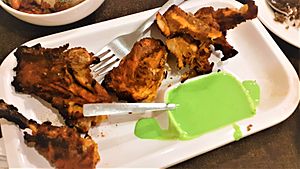Non-vegetarian facts for kids
Non-vegetarian food means food that includes meat (like red meat, poultry such as chicken, seafood, or the flesh of any other animal). Sometimes, it also includes eggs. When we talk about people, non-vegetarians are those who eat meat, unlike vegetarians who don't. Eating non-vegetarian food is the most common way people eat around the world, including in India. In science, non-vegetarians are also called omnivores because they eat both plants and animals.
Contents
When the Term "Non-Vegetarian" Was First Used
The word 'vegetarian' started to be used more often around 1839. It became widely known after the Vegetarian Society was formed in 1847 in Ramsgate, UK. The word non-vegetarian was first used in 1883, according to Merriam Webster.

Who Eats Non-Vegetarian Food?
Most people around the world, about 91-92%, eat non-vegetarian food. This means they are not strict vegetarians or vegans. A survey in 2018 showed that 74% of people regularly eat both animal and plant products. About 14% eat meat or fish only sometimes, and 3% eat fish but no other meat. Only 3% of people are vegan, meaning they don't eat any animal products at all.
In India, about 75% of people are not vegetarian, according to a survey from 2005-06. By 2015-16, this number was 78% for women and 70% for men. Some studies suggest that the actual number of vegetarians in India might be even lower than reported. This is because some people might say they are vegetarian due to social or cultural reasons, even if they eat meat sometimes.
By Gender
In India, more men eat non-vegetarian food than women. About 43% of Indian women and 49% of men eat fish, chicken, or meat every week. Almost three out of ten women (29%) do not eat eggs, and 30% do not eat chicken, fish, or meat. For men, these numbers are lower: 20% do not eat eggs, and 22% do not eat chicken, fish, or meat.
Among women aged 15 to 45, about 37% eat eggs weekly, and 37% eat fish, chicken, or meat weekly. Many also eat milk, curd, pulses, beans, and leafy vegetables daily.
By Education, Religion, and Caste

The amount of non-vegetarian food people eat can depend on their education. People who have studied for up to five years tend to eat the most eggs and meat. For men, this is 54% for eggs and 58% for meat. For women, it's 48% for eggs and 52% for meat.
Among different religions in India, Christians eat the most eggs and meat. About 71.5% of Christian men and 65% of Christian women eat eggs. For meat, it's 76% of men and 74% of women. Muslims follow next, with 66.5% of men and 60% of women eating eggs, and 73% of men and 67% of women eating meat. Even though Hindus make up 80% of India's population, many of them also eat meat. Only about a third of upper-caste Indians are vegetarian.
By State
Some states in India have more people who eat non-vegetarian food than others. For women, the highest weekly consumers of fish, chicken, or meat are in Kerala (93%), Goa (86%), and Assam (80%). The lowest are in Punjab (4%), Rajasthan (6%), and Haryana (8%).
For men, Tripura (95%), Kerala (90%), and Goa (88%) have the most weekly consumers of fish, chicken, or meat. The lowest are Punjab (10%), Rajasthan (10%), and Haryana (13%).
History of Non-Vegetarian Food in India
Archaeological discoveries show that people in the ancient Indus Valley Civilisation often ate meat from animals like cattle, buffalo, goat, pig, and chicken. They also used dairy products. Evidence suggests that people across this region had similar eating habits, which included meat, fats, and plants. These eating patterns stayed the same even as the civilisation declined.
Non-Vegetarian Food in Everyday Life

Food Labels
In India, it's required by law for packaged food products to have special marks that show if they are vegetarian or non-vegetarian. A green symbol means vegetarian, and a reddish-brown symbol means non-vegetarian. This rule started in 2006 and became mandatory in 2011. Non-vegetarian food is defined as any food that contains any part of an animal, including birds, sea animals, eggs, or products from animals, but not milk or milk products.
A court instruction in 2021 reminded food businesses to follow this rule strictly. It said that even a tiny amount of animal product makes food non-vegetarian and must be declared. If they don't follow this, they could face legal action.
Restaurant Signs

In India, most restaurants that serve meat clearly put up signs saying 'non-vegetarian restaurant' or 'non-vegetarian hotel'. This helps strict vegetarians, who might avoid eating in such places for religious or cultural reasons, or because they care about animal welfare. Even Mahatma Gandhi once wrote about his struggle as a vegetarian deciding whether to eat a vegetarian meal in a non-vegetarian restaurant.
Popular Non-Vegetarian Dishes
Indian Meat Dishes
- Butter chicken: A popular dish from North India.
- Tandoori chicken: A famous dish from the Indian subcontinent.
- Rogan josh: A flavorful dish from Kashmir.
- Machher Jhol: A traditional fish curry from Bengal.
- Biriyani: A rice dish with meat, originally from the Mughal Empire.
Meat Dishes from Other Countries
Some meat dishes that are not originally from India are also very popular. You can find some Continental food dishes in fancy Indian restaurants. Also, Indian Chinese cuisine offers many chicken dishes like chicken with chilli, garlic, ginger, Jalfrezi, or lemon. Momo (food) (dumplings) are also very popular. These can be found in regular restaurants or as street food in big cities across India. Kababs, which are from the Middle East, are also widely available in street shops and restaurants.



